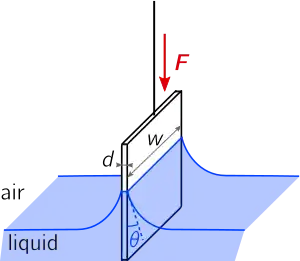Wilhelmy plate
A Wilhelmy plate is a thin plate that is used to measure equilibrium surface or interfacial tension at an air–liquid or liquid–liquid interface. In this method, the plate is oriented perpendicular to the interface, and the force exerted on it is measured. Based on the work of Ludwig Wilhelmy, this method finds wide use in the preparation and monitoring of Langmuir films.

Detailed description
The Wilhelmy plate consists of a thin plate usually on the order of a few square centimeters in area. The plate is often made from filter paper, glass or platinum which may be roughened to ensure complete wetting. In fact, the results of the experiment do not depend on the material used, as long as the material is wetted by the liquid.[1] The plate is cleaned thoroughly and attached to a balance with a thin metal wire. The force on the plate due to wetting is measured using a tensiometer or microbalance and used to calculate the surface tension () using the Wilhelmy equation:
where is the wetted perimeter (), is the plate width, is the plate thickness, and is the contact angle between the liquid phase and the plate. In practice the contact angle is rarely measured; instead, either literature values are used or complete wetting () is assumed.
Advantages and short brief
If complete wetting is assumed (contact angle = 0), no correction factors are required to calculate surface tensions when using the Wilhelmy plate, unlike for a du Noüy ring. In addition, because the plate is not moved during measurements, the Wilhelmy plate allows accurate determination of surface kinetics on a wide range of timescales, and it displays low operator variance. In a typical plate experiment, the plate is lowered to the surface being analyzed until a meniscus is formed, and then raised so that the bottom edge of the plate lies on the plane of the undisturbed surface. If measuring a buried interface, the second (less dense) phase is then added on top of the undisturbed primary (denser) phase in such a way as to not disturb the meniscus. The force at equilibrium can then be used to determine the absolute surface or interfacial tension. Due to a large wetted area of the plate, the measurement is less susceptible for measurement errors than when using a smaller probe. Also, the method has been described in several international measurement standards.
Further reading
- Holmberg, K (ed.) Handbook of Applied Surface and Colloid Chemistry New York, Wiley and Sons: 2002. Vol. 2, p. 219
References
- Butt, Hans-Jürgen; Graf, Karlheinz; Kappl, Michael (2006). Physics and chemistry of interfaces (2., rev. and enl. ed.). Weinheim: Wiley-VCH-Verl. p. 16. ISBN 9783527406296.